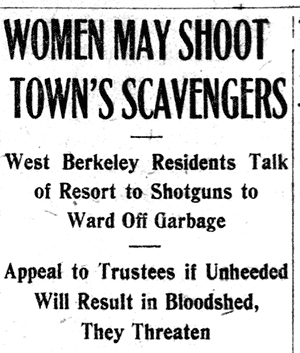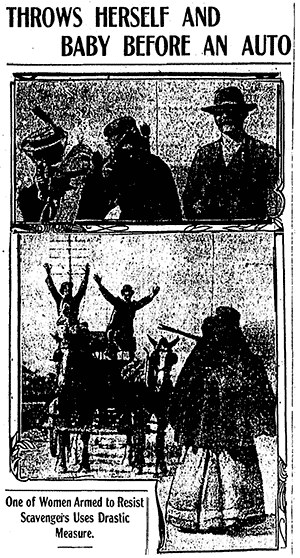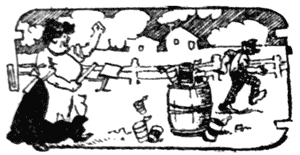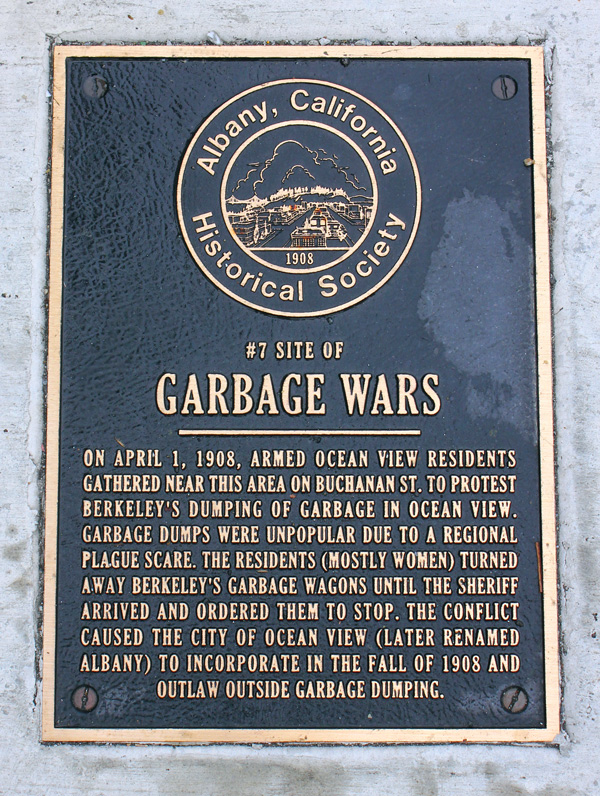On the morning of April 2, 1908, a sensational image greeted the readers of the San Francisco Call Bulletin. On the front page was a photo of a young woman, dressed in a feathered boater and what looks like a fur dangling off her shoulder. With her left hand, she clasped a baby in a bonnet and booties; with her right, she coolly aimed a pistol. A version of this article first appeared on Albany Patch in April 2012. While I’d asserted that this incident has been “forgotten,” readers pointed out that the garbage war is taught as part of Albany’s third-grade history curriculum, with kids reenacting the conflict. In late 2012, the Albany Historical Society and the city installed a plaque at the site of the armed showdown between residents and garbage dumpers.The headline declared, “Armed Women Take Hand in Garbage War…Shotguns Are Displayed in Berkeley…Auto is Stopped by Baby Being Hurled in Its Path.”
Mrs. F.A. Olsen “hurled her baby and carriage” in front of a moving car, according to the San Francisco Call Bulletin.
This striking—perhaps staged—photo marked the climax of the Berkeley garbage war of 1908, a brief, bloodless skirmish in which local women successfully took up arms to prevent the city from dumping its trash in their backyards. Oddly, despite its cast of gun-toting, baby-hurling, proto-environmentalist mothers, the conflict has been all but ignored by histories of Berkeley.
The best (and most entertaining) accounts of the garbage war come from the local newspapers of the time, which kept close tabs on Berkeley’s growing obsession with all things refuse-related. In 1908, the city kept 35 rat catchers on its payroll at a cost of $70 a day. UC Berkeley students were instructed in vermin eradication and let out of class to attend a lecture titled “A Clean City.” Yet the booming college town’s most worrisome concern was finding an effective way to get rid of its trash. The city trustees entertained proposals to build an incinerator or dump the waste at sea. But they kept coming back to the easiest option: collecting refuse and leaving it along the edge of San Francisco Bay. As one civic booster told the Berkeley Daily Gazette, “The shores of the bay offer the only logical place to dump the city’s waste.’
Not in their backyards
Unsurprisingly, this was not popular with people who lived by the bay. In late February 1908, armed residents of Contra Costa County chased off Berkeley scavengers dumping trash just over the county line. Shortly afterwards, the city made a deal with West Berkeley trustee George Schmidt to dump on his shorefront property at the foot of Gilman Street in the Ocean View district.
The complaints began immediately. “When the tide is high the garbage is carried up against our front yard fence,” Mrs. Frank Connor told the San Francisco Call. “The mothers and children suffer most from this outrage,” Mrs. Joseph Smart told the San Francisco Chronicle. “Last summer the same thing was tried, and flies and stench made the place unbearable.”
This time, however, the residents of Ocean View pushed back. “If nothing else will help, we must follow the example of the people of the county line and resort to the use of shotguns,” Smart said. Schmidt reported that his constituents “had reviled  From the San Francisco Call Bulletinhim personally for permitting [the dumping], and had even threatened to use force in preventing the nuisance being continued.” After meeting with the members of the newly formed West End Protective Association, he declared his land off limits for further dumping. “If the worst comes to the worst,” Protective Association president Ella de Veau told the city trustees, “the women stand ready to back up the men with force if necessary, in upholding our rights. You have permitted the spoiling of our beach for pleasure purposes, but you shall not endanger our lives. You appear to think the people of West Berkeley exist only for your convenience.”
From the San Francisco Call Bulletinhim personally for permitting [the dumping], and had even threatened to use force in preventing the nuisance being continued.” After meeting with the members of the newly formed West End Protective Association, he declared his land off limits for further dumping. “If the worst comes to the worst,” Protective Association president Ella de Veau told the city trustees, “the women stand ready to back up the men with force if necessary, in upholding our rights. You have permitted the spoiling of our beach for pleasure purposes, but you shall not endanger our lives. You appear to think the people of West Berkeley exist only for your convenience.”
A new dump site was found, and the trash wagons kept coming. The Protective Association stretched “a rude wire fence” across Delaware Street and posted lookouts along the route to the dump. Many of the sentries were women, assisted by “a brigade of boys with stones and a few men not otherwise employed” according to the Chronicle. (“Most of the small boys,” the Call elaborated, “were kept home from school by their mothers so they could be on hand to stone the scavengers should they make an appearance.”)
The “mad mob” mobilizes
The garbage war began in earnest on March 26. After the city broke a short-lived truce, a large crowd assembled at Third and Gilman Streets, wielding “broomsticks, pokers, rocks and other missiles,” according the Call’s report of the scene. When a procession of 10 trash wagons approached, it was stopped by a hail of stones thrown by “indignant women.”
The following evening, the Berkeley trustees repealed an ordinance banning dumping within 500 yards of a residence, giving the scavengers the right to dump anywhere in city limits. “These garbage men will discover that we are all fighters before they finish up the matter.”Yet the roads into Ocean View remained blocked, and more than 150 tons of trash accumulated in Berkeley, including in the backyards of “the fashionable members of the hillside set,” as the Call recounted beneath the headline, “Garbage is Piled High in Berkeley.” The Chronicle reported that the owners of one hotel were “at their wits’ end,” having been forced to burn their rotting trash in a vacant lot in the center of town.
The final showdown took place April 1. The Chronicle reported “a band of nearly fifty citizens, most of them women, and all armed with shotguns, revolvers, clubs and clods of earth” assembled just outside the town line at the intersection of San Pablo and Buchanan, again reinforced by “a host of small boys ready to throw rocks at the horses.” The Gazette, which took a dim view of the anti-dumping campaign, described a “mad mob” headed by four women from the Protective Association, all “armed to the teeth.” With cries of “S’help me Jolly Roger!”, the “hoodlumists” prevented any garbage wagons from turning west toward the shoreline.
“Our little fiasco”
Tensions escalated when some of the directors of the city Chamber of Commerce drove down San Pablo Avenue to reconnoiter the dumping ground, followed by three garbage wagons. As the car approached, reported the Chronicle, Mrs. F.A. Olsen, holding an unloaded revolver, “threw herself and her infant in the path of the speeding machine in order to stop it.” The Call claimed that Olsen “hurled her baby and carriage” in front of the car. The vehicle reportedly stopped just in time. Meanwhile, wrote the Call, “afraid of their lives, the scavengers, after a short consultation, decided that discretion was the better part of valor and turned back their wagons and awaited orders from their chief.”
 Photos “from the dead line for scavengers” in the San Francisco Chronicle may have been posed for dramatic effect.
Photos “from the dead line for scavengers” in the San Francisco Chronicle may have been posed for dramatic effect.  A woman chases away a garbage dumper in this cartoon from the San Francisco Call Bulletin.
A woman chases away a garbage dumper in this cartoon from the San Francisco Call Bulletin.Mrs. H.C. Hanscomb, the pistol-packing woman pictured on the front page of the Call, told the Gazette, “My folks are fighters from way back. My grandfather was a fighter in the French and Indian War. Then just tell me why I should not be a fighter. These garbage men will discover that we are all fighters before they finish up the matter.” She suggested an alternative site for the city to dump its waste: “Let them take it back of the hills where there are no people living to smell it.”
The Chronicle and Call’s colorful accounts of the day were later questioned by W.M. Wright, a member of the Protective Association who lived at San Pablo and Marin. He told the Gazette that “The papers have greatly exaggerated our little fiasco out here. There is absolutely no truth in the report that one mother attempted to throw herself and her child in front of an automobile.” Also, he insisted, “It is true that some of the women became excited and did have guns at first, but all of the pictures that appeared in the San Francisco papers were arranged by the reporters, who had the women strike that attitude just for the sake of getting a picture.” Considering that both papers rarely ran any photographs more exciting than portraits (the Gazette had no photography at all), the suggestion that the photos were set up seems entirely possible.
Nonetheless, it was agreed that the armed women of Ocean View had brought matters to a head. There was a short ceasefire after Berkeley police chief August Vollmer and the sheriff convinced them to allow the garbage wagons to head to the old bone yard south of McKeevers Hill (today Albany Hill). However, after the scavengers passed and the cops left, “the crowd of amazon vigilantes,” as the Chronicle put it, continued to stop all wagons on San Pablo “until their identity and intentions were learned.”
The following day, a judge issued a temporary injunction prohibiting any dumping 1,000 yards north or south of Buchanan Street, and the garbage war came to an end. Though there were no further incidents of armed resistance to trash dumping, the rift between Berkeley and Ocean View did not heal. On Sept. 15, the western part of Ocean View officially seceded from the city altogether. The newly elected trustees of the breakaway town, which would be renamed Albany in October 1909, declared that their first order of business would be to ban all garbage dumping within city limits.

Plaque at the corner of San Pablo Ave. and Buchanan St., Albany